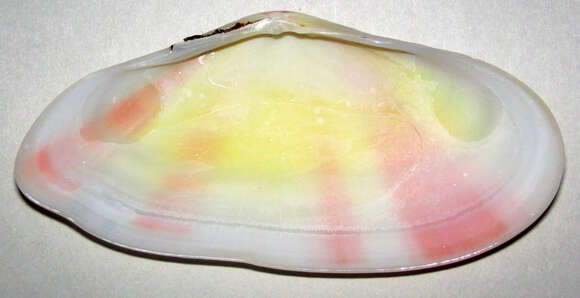Tellina radiata (sunrise tellin clam) (St. Thomas, Virgin Islands) 2

Description :
Description: English: Tellina radiata Linnaeus, 1758 - interior of a left valve of the sunrise tellin clam from the Virgin Islands. Bivalves are bilaterally symmetrical molluscs having two calcareous, asymmetrical shells (valves) - they include the clams, oysters, and scallops. In most bivalves, the two shells are mirror images of each other (the major exception is the oysters). They occur in marine, estuarine, and freshwater environments. Bivalves are also known as pelecypods and lamellibranchiates. Bivalves are sessile, benthic organisms - they occur on or below substrates. Most of them are filter-feeders, using siphons to bring in water, filter the water for tiny particles of food, then expel the used water. The majority of bivalves are infaunal - they burrow into unlithified sediments. In hard substrate environments, some forms make borings, in which the bivalve lives. Some groups are hard substrate encrusters, using a mineral cement to attach to rocks, shells, or wood. The fossil record of bivalves is Cambrian to Recent. They are especially common in the post-Paleozoic fossil record. Seen here is a sunrise tellin clam shell, a colorful species in Family Tellinidae. Tellin bivalves first appeared in the Cretaceous - they are infaunal filter-feeders that inhabit estuarine and marine settings. Classification: Animalia, Mollusca, Bivalvia, Heterodonta, Cardiida, Tellinidae Locality: St. Thomas, western Virgin Islands See info. at: en.wikipedia.org/wiki/Tellina_radiata. Date: 29 September 2020, 16:49:19. Source: https://www.flickr.com/photos/47445767@N05/50410475566/. Author: James St. John.
Inclus dans les pages suivantes :
- Life
- Cellular (Organismes cellulaires)
- Eukaryota (eucaryotes)
- Opisthokonta
- Metazoa (animaux)
- Bilateria
- Protostomia
- Spiralia
- Mollusca (mollusques)
- Bivalvia
- Autobranchia
- Heteroconchia
- Euheterodonta
- Imparidentia
- Cardiida
- Tellinoidea
- Tellinidae
- Tellininae
- Tellina
- Tellina radiata
Cette image ne figure dans aucune collection.
Informations sur la provenance
- licence
- cc-by-3.0
- droit d’auteur
- James St. John
- créateur
- James St. John
- source
- James St. John (47445767@N05)
- original
- fichier de média d’origine
- visiter la source
- site partenaire
- Wikimedia Commons
- ID


